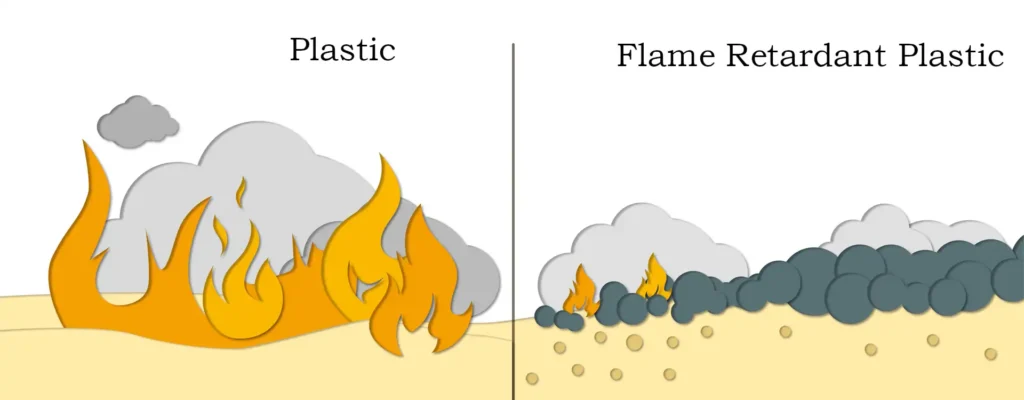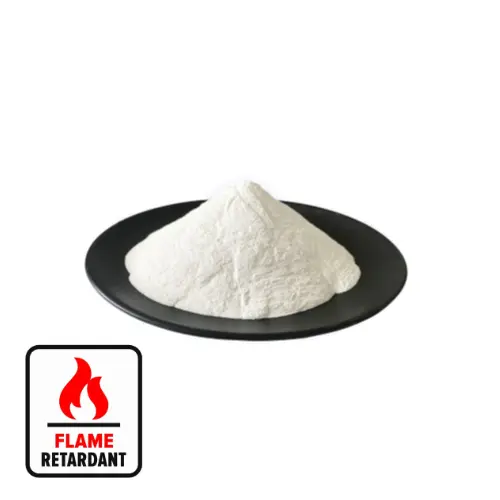Flame retardants can be divided into two categories, organic flame retardants and inorganic flame retardants, according to their chemical composition. Organic flame retardants are divided into two series: phosphorus and halogen. Due to the existence of organic flame retardants decomposition products of toxicity, smoke and other shortcomings, is gradually replaced by inorganic flame retardants. The main varieties of inorganic flame retardants are aluminum hydroxide, magnesium hydroxide, red phosphorus, antimony oxide, tin oxide, molybdenum oxide, ammonium molybdate, zinc borate, etc., of which aluminum hydroxide and magnesium hydroxide due to the decomposition of the absorption of heat and produce H2O can play a role in isolation of the air, and its decomposition of oxides and high-temperature-resistant substances, so the two kinds of flame retardant not only to play a role in fire-retardant, but also to play a role in filling, which does not have the production of corrosive halogen gas and hazardous gases, but also has the following features It has the characteristics of not producing corrosive halogen gas and harmful gases, not volatile, long-lasting effect, non-toxic, non-smoke, non-dripping and so on.

Magnesium hydroxide when heated (340-490 degrees) decomposition occurs to absorb the heat of the surface of the burning material to the flame retardant effect; at the same time release a large amount of water to dilute the oxygen on the surface of the combustible material, decomposition of active magnesium oxide generated by the surface of the combustible material attached to the combustible material to further prevent the combustion of the combustion process. Magnesium hydroxide in the whole flame retardant process not only does not have any harmful substances, and its decomposition products in the flame retardant at the same time can also be a large number of absorption of rubber, plastics and other polymer combustion of harmful gases and smoke, activated magnesium oxide continues to absorb incomplete combustion of the melting residue from the combustion will soon stop at the same time eliminating smoke, preventing the melting of the droplets, is a kind of emerging environmentally friendly inorganic flame retardants. Magnesium hydroxide flame retardant through the thermal decomposition of the release of bound water, absorbing a large amount of latent heat to reduce the surface temperature of the synthetic material it fills in the flame, with the inhibition of the decomposition of polymers and the resulting combustible gases to cool the role.
Magnesium hydroxide is white solid powder, insoluble in alkaline substances, heat decomposition into magnesium oxide and water, heated to 340 ° C began to decompose, 430 ° C decomposition speed is the fastest, to 490 ° C complete decomposition. Magnesium hydroxide crystals belong to the 2-valent metal hydrate family, the crystal structure is layered CdI2 type, forming a continuous hexagonal shape, the Mg2+ layer and the OH– layer overlap each other, and each magnesium ion is cooperated by 6 hydroxide ions thus forming Mg(OH)6 octahedron. Magnesium hydroxide has many advantages:
(1) The decomposition temperature of magnesium hydroxide is 340–490℃, which can make the filled material bear higher processing temperature, which is helpful to speed up the extrusion speed and shorten the molding time. And the decomposition energy of magnesium hydroxide is bigger, high heat capacity, can absorb more heat, flame retardant effect is better.
(2) The particle size of magnesium hydroxide is small, less wear and tear on the material processing equipment, which is conducive to prolonging the service life of the equipment.
(3) Magnesium hydroxide has good smoke reduction effect and can neutralize the toxic gases produced by polymer combustion such as sulfur dioxide, carbon dioxide and so on.
(4) Raw materials are abundant and easy to obtain, seawater resources contain a large number of magnesium salts, as well as magnesium ores such as magnesite, dolomite and hydromagnesite.
Application studies have shown that when the added hydroxide particle size is reduced to 1um, the oxygen index of its flame retardant polymer system is significantly improved. Many literatures report that with the reduction of particle size, the inorganic particles have the effect of enhancing the toughness of the polymer materials. Therefore, ultrafine becomes an important development direction of magnesium hydroxide flame retardant. Inside material science, people call ultrafine particles as nanoparticles, which are a kind of substable intermediate state material between solid and molecule. Nano magnesium hydroxide (VK-MHT01) refers to magnesium hydroxide with particle size between 1-100nm. As a kind of nano-material, it has the common characteristics that nano-materials have, i.e., small size effect, quantum size effect, surface effect, macroscopic quantum effect, etc. Filling in composite materials with it can greatly improve the flame retardant, mechanical and other properties of the materials. Studies have shown that the flame retardant properties of plastics with nano-magnesium hydroxide are better than those of ordinary magnesium hydroxide-filled plastics, with better machinability. Compared with organic flame retardants containing phosphorus and halogens, nano-magnesium hydroxide (VK-MHT01) is non-toxic, tasteless, and has the triple function of flame retardant, filling, and smoke suppression, which is the ideal additive for the development of flame-retardant polymers, and it has received widespread attention.
The researchers investigated the flame retardant properties of nano-magnesium hydroxide and micrometer magnesium hydroxide filled polypropylene ((PP) systems, the flow properties and. mechanical properties. The experimental results show that when adding the same mass fraction of magnesium hydroxide, the flame retardancy of nano-magnesium hydroxide-filled system is better than that of the micrometer magnesium hydroxide-filled system and reaches the standard of v-o level when the filler amount is 60%, and the amount of smoke is less, and the fluidity and mechanical properties are also better than that of the micrometer magnesium hydroxide-filled system.
With the development of polymer materials, the flammability of polymer materials has been increasingly emphasized, and the demand for flame retardants has increased. However, as people put forward more stringent requirements on the environment and other factors, flame retardant halogen-free, high efficiency, smoke suppression, non-toxicity has become the future development trend. Nano magnesium hydroxide is a high efficient halogen-free flame retardant with good flame retardant properties, does not produce secondary pollution after fire, and has strong smoke suppression, non-toxic, non-corrosive, non-volatile, non-dissipative, safe and so on, it has been recognized as an environmentally friendly flame retardant, it is because of magnesium hydroxide’s safe, environmentally friendly characteristics, in the plastics, cables, rubber, and other industries have been widely used. China has rich resources of magnesium-containing minerals and magnesium-rich wastes, so the prospect of nano-magnesium hydroxide flame retardant filler is very broad.

